Li-Hsiang Shen
RIS-Aided Fluid Antenna Array-Mounted UAV Networks
Jan 16, 2025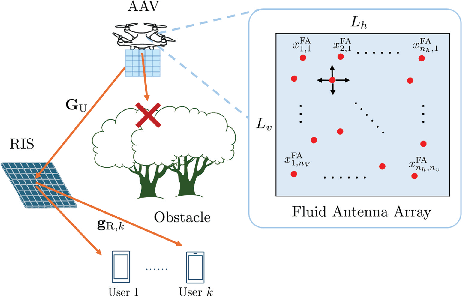

Abstract:This paper investigates reconfigurable intelligent surface (RIS)-assisted unmanned aerial vehicle (UAV) downlink networks with fluid antennas (FA), where RIS enables non-line-of-sight (NLoS) transmissions. Moreover, the FA is equipped on the UAV offering dynamic antenna position adjustment, enhancing spatial diversity besides UAV deployment. We aim at total downlink rate maximization while ensuring minimum user rate requirement. We consider joint optimization of active UAV beamforming, passive RIS beamforming, UAV deployment and FA position adjustment. To address the complex problem, we propose beamfomring for RIS/UAV and FA-UAV deployment (BRAUD) scheme by employing alternative optimization, successive convex approximation (SCA) and sequential rank-one constraint relaxation (SROCR) method for the decomposed subproblems. Simulation results demonstrate the effectiveness of RIS-FA-UAV, achieving the highest rate among existing architectures without FA/UAV/RIS deployment and without proper beamforming. Moreover, BRAUD achieves the highest rate among benchmarks of drop-rank method, heuristic optimizations and conventional zero-forcing beamforming as well as random method.
Energy Efficient Beamforming Training in Terahertz Communication Systems
Sep 27, 2024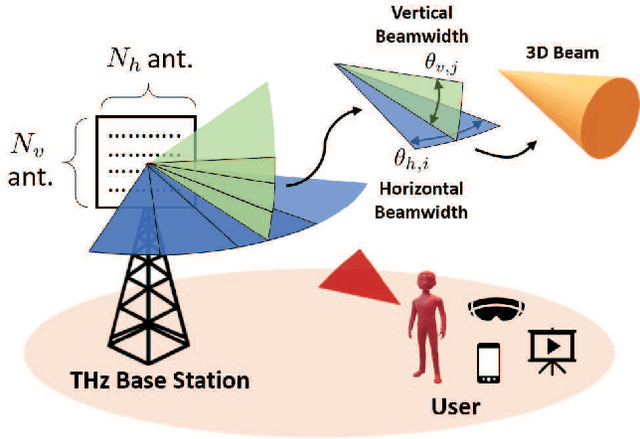
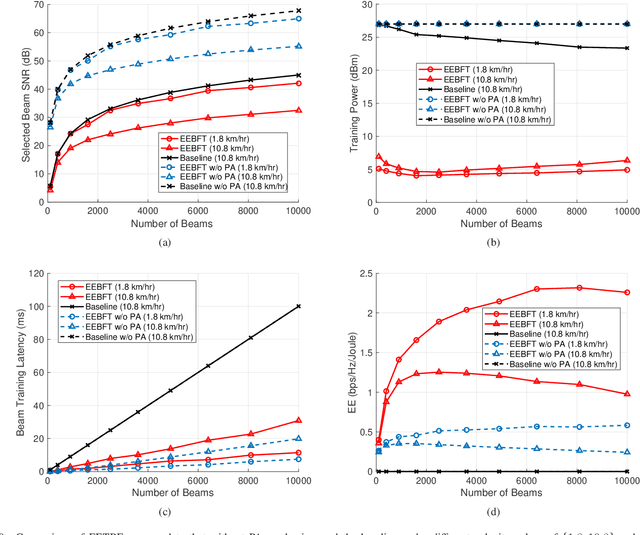

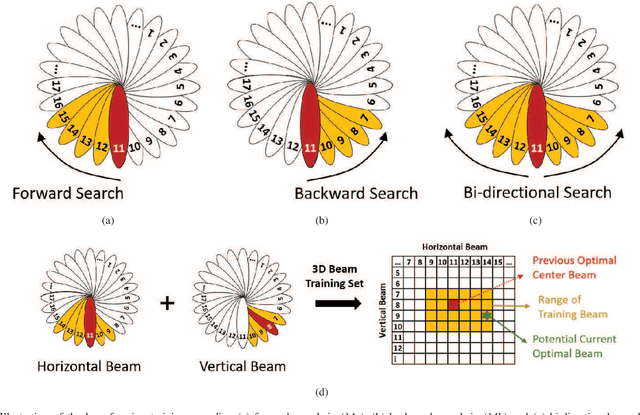
Abstract:Terahertz (THz) enables promising Tbps-level wireless transmission thanks to its prospect of ultra-huge spectrum utilization and narrow beamforming in the next sixth-generation (6G) communication system. Compared to millimeter wave (mmWave), THz intrinsically possesses compellingly severer molecular absorption and high pathloss serving confined coverage area. These defects should be well conquered under the employment of ultra-thin 3D beamforming with enormous deployed antennas with high beam gains. However, pencil-beams require substantially high overhead of time and power to train its optimal THz beamforming direction. We propose an energy efficient (EE) oriented THz beamforming (EETBF) scheme by separating the original complex problem into beamforming training (EETBF-BT) acquirement and learning-enabled training power assignment (EETBF-PA). The historical beam data is employed to update next beam selection policy. The performance results have demonstrated that the proposed EETBF outperforms the existing benchmarks leveraging full beam search, iterative search, linear/binary search as well as non-power-control based mechanism in open literature. Our proposed EETBF scheme results in the lowest training latency and power consumption, achieving the highest effective rate and EE performance.
AI-Enabled Unmanned Vehicle-Assisted Reconfigurable Intelligent Surfaces: Deployment, Prototyping, Experiments, and Opportunities
Nov 06, 2023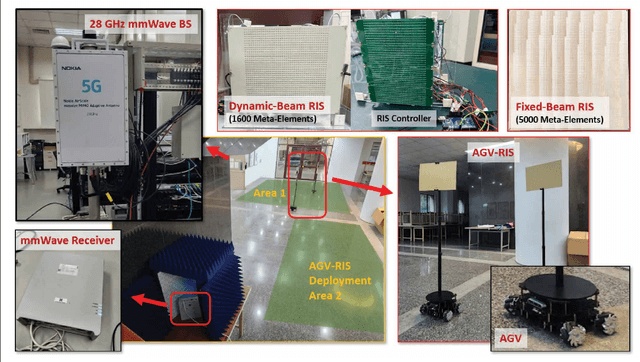
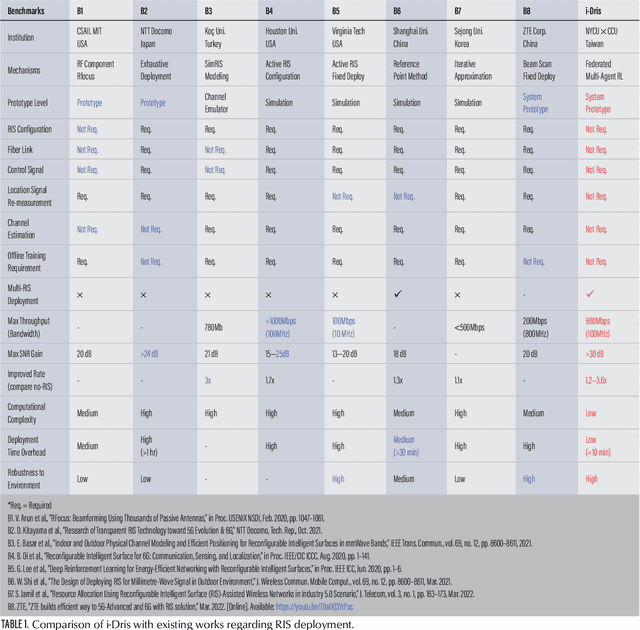
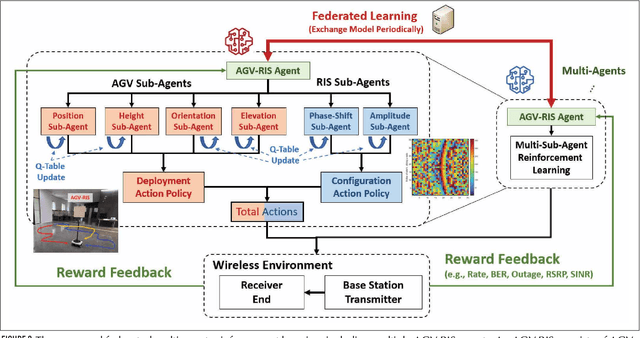
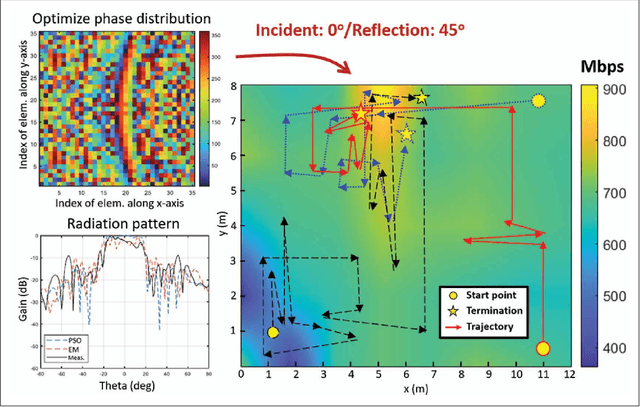
Abstract:The requirement of wireless data demands is increasingly high as the sixth-generation (6G) technology evolves. Reconfigurable intelligent surface (RIS) is promisingly deemed to be one of 6G techniques for extending service coverage, reducing power consumption, and enhancing spectral efficiency. In this article, we have provided some fundamentals of RIS deployment in theory and hardware perspectives as well as utilization of artificial intelligence (AI) and machine learning. We conducted an intelligent deployment of RIS (i-Dris) prototype, including dual-band auto-guided vehicle (AGV) assisted RISs associated with an mmWave base station (BS) and a receiver. The RISs are deployed on the AGV with configured incident/reflection angles. While, both the mmWave BS and receiver are associated with an edge server monitoring downlink packets for obtaining system throughput. We have designed a federated multi-agent reinforcement learning scheme associated with several AGV-RIS agents and sub-agents per AGV-RIS consisting of the deployment of position, height, orientation and elevation angles. The experimental results presented the stationary measurement in different aspects and scenarios. The i-Dris can reach up to 980 Mbps transmission throughput under a bandwidth of 100 MHz with comparably low complexity as well as rapid deployment, which outperforms the other existing works. At last, we highlight some opportunities and future issues in leveraging RIS-empowered wireless communication networks.
D-STAR: Dual Simultaneously Transmitting and Reflecting Reconfigurable Intelligent Surfaces for Joint Uplink/Downlink Transmission
Jul 30, 2023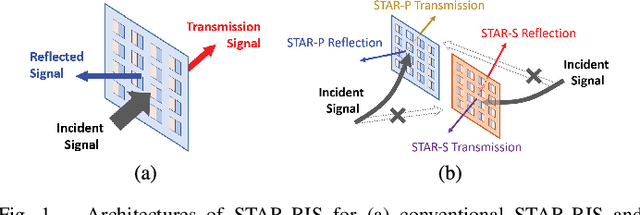



Abstract:The joint uplink/downlink (JUD) design of simultaneously transmitting and reflecting reconfigurable intelligent surfaces (STAR-RIS) is conceived in support of both uplink (UL) and downlink (DL) users. Furthermore, the dual STAR-RISs (D-STAR) concept is conceived as a promising architecture for 360-degree full-plane service coverage including users located between the base station (BS) and the D-STAR and beyond. The corresponding regions are termed as primary (P) and secondary (S) regions. The primary STAR-RIS (STAR-P) plays an important role in terms of tackling the P-region inter-user interference, the self-interference (SI) from the BS and from the reflective as well as refractive UL users imposed on the DL receiver. By contrast, the secondary STAR-RIS (STAR-S) aims for mitigating the S-region interferences. The non-linear and non-convex rate-maximization problem formulated is solved by alternating optimization amongst the decomposed convex sub-problems of the BS beamformer, and the D-STAR amplitude as well as phase shift configurations. We also propose a D-STAR based active beamforming and passive STAR-RIS amplitude/phase (DBAP) optimization scheme to solve the respective sub-problems by Lagrange dual with Dinkelbach transformation, alternating direction method of multipliers (ADMM) with successive convex approximation (SCA), and penalty convex-concave procedure (PCCP). Our simulation results reveal that the proposed D-STAR architecture outperforms the conventional single RIS, single STAR-RIS, and half-duplex networks. The proposed DBAP in D-STAR outperforms the state-of-the-art solutions in the open literature.
SALC: Skeleton-Assisted Learning-Based Clustering for Time-Varying Indoor Localization
Jul 14, 2023Abstract:Wireless indoor localization has attracted significant amount of attention in recent years. Using received signal strength (RSS) obtained from WiFi access points (APs) for establishing fingerprinting database is a widely utilized method in indoor localization. However, the time-variant problem for indoor positioning systems is not well-investigated in existing literature. Compared to conventional static fingerprinting, the dynamicallyreconstructed database can adapt to a highly-changing environment, which achieves sustainability of localization accuracy. To deal with the time-varying issue, we propose a skeleton-assisted learning-based clustering localization (SALC) system, including RSS-oriented map-assisted clustering (ROMAC), cluster-based online database establishment (CODE), and cluster-scaled location estimation (CsLE). The SALC scheme jointly considers similarities from the skeleton-based shortest path (SSP) and the time-varying RSS measurements across the reference points (RPs). ROMAC clusters RPs into different feature sets and therefore selects suitable monitor points (MPs) for enhancing location estimation. Moreover, the CODE algorithm aims for establishing adaptive fingerprint database to alleviate the timevarying problem. Finally, CsLE is adopted to acquire the target position by leveraging the benefits of clustering information and estimated signal variations in order to rescale the weights fromweighted k-nearest neighbors (WkNN) method. Both simulation and experimental results demonstrate that the proposed SALC system can effectively reconstruct the fingerprint database with an enhanced location estimation accuracy, which outperforms the other existing schemes in the open literature.
Robust Active and Passive Beamforming for RIS-Assisted Full-Duplex Systems under Imperfect CSI
Jun 09, 2023Abstract:The sixth-generation (6G) wireless technology recognizes the potential of reconfigurable intelligent surfaces (RIS) as an effective technique for intelligently manipulating channel paths through reflection to serve desired users. Full-duplex (FD) systems, enabling simultaneous transmission and reception from a base station (BS), offer the theoretical advantage of doubled spectrum efficiency. However, the presence of strong self-interference (SI) in FD systems significantly degrades performance, which can be mitigated by leveraging the capabilities of RIS. Moreover, accurately obtaining channel state information (CSI) from RIS poses a critical challenge. Our objective is to maximize downlink (DL) user data rates while ensuring quality-of-service (QoS) for uplink (UL) users under imperfect CSI from reflected channels. To address this, we introduce the robust active BS and passive RIS beamforming (RAPB) scheme for RIS-FD, accounting for both SI and imperfect CSI. RAPB incorporates distributionally robust design, conditional value-at-risk (CVaR), and penalty convex-concave programming (PCCP) techniques. Additionally, RAPB extends to active and passive beamforming (APB) with perfect channel estimation. Simulation results demonstrate the UL/DL rate improvements achieved considering various levels of imperfect CSI. The proposed RAPB/APB schemes validate their effectiveness across different RIS deployment and RIS/BS configurations. Benefited from robust beamforming, RAPB outperforms existing methods in terms of non-robustness, deployment without RIS, conventional successive convex approximation, and half-duplex systems.
Federated Deep Reinforcement Learning for THz-Beam Search with Limited CSI
Apr 25, 2023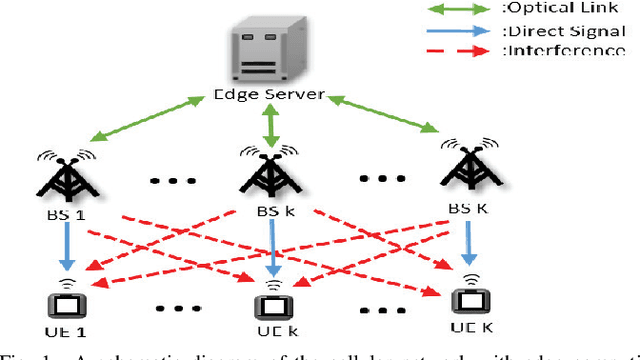

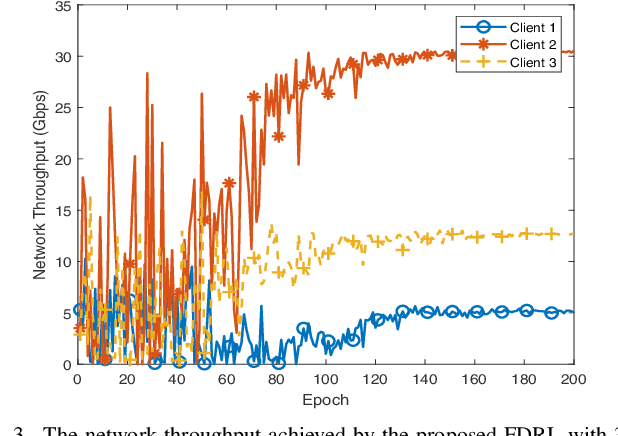
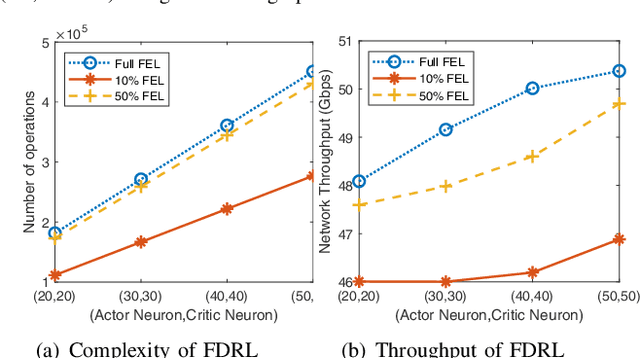
Abstract:Terahertz (THz) communication with ultra-wide available spectrum is a promising technique that can achieve the stringent requirement of high data rate in the next-generation wireless networks, yet its severe propagation attenuation significantly hinders its implementation in practice. Finding beam directions for a large-scale antenna array to effectively overcome severe propagation attenuation of THz signals is a pressing need. This paper proposes a novel approach of federated deep reinforcement learning (FDRL) to swiftly perform THz-beam search for multiple base stations (BSs) coordinated by an edge server in a cellular network. All the BSs conduct deep deterministic policy gradient (DDPG)-based DRL to obtain THz beamforming policy with limited channel state information (CSI). They update their DDPG models with hidden information in order to mitigate inter-cell interference. We demonstrate that the cell network can achieve higher throughput as more THz CSI and hidden neurons of DDPG are adopted. We also show that FDRL with partial model update is able to nearly achieve the same performance of FDRL with full model update, which indicates an effective means to reduce communication load between the edge server and the BSs by partial model uploading. Moreover, the proposed FDRL outperforms conventional non-learning-based and existing non-FDRL benchmark optimization methods.
Time-Selective RNN for Device-Free Multi-Room Human Presence Detection Using WiFi CSI
Apr 25, 2023Abstract:Human presence detection is a crucial technology for various applications, including home automation, security, and healthcare. While camera-based systems have traditionally been used for this purpose, they raise privacy concerns. To address this issue, recent research has explored the use of channel state information (CSI) approaches that can be extracted from commercial WiFi access points (APs) and provide detailed channel characteristics. In this thesis, we propose a device-free human presence detection system for multi-room scenarios using a time-selective conditional dual feature extract recurrent Network (TCD-FERN). Our system is designed to capture significant time features with the condition on current human features using a dynamic and static (DaS) data preprocessing technique to extract moving and spatial features of people and differentiate between line-of-sight (LoS) path blocking and non-blocking cases. To mitigate the feature attenuation problem caused by room partitions, we employ a voting scheme. We conduct evaluation and real-time experiments to demonstrate that our proposed TCD-FERN system can achieve human presence detection for multi-room scenarios using fewer commodity WiFi APs.
Attention-Enhanced Deep Learning for Device-Free Through-the-Wall Presence Detection Using Indoor WiFi System
Apr 25, 2023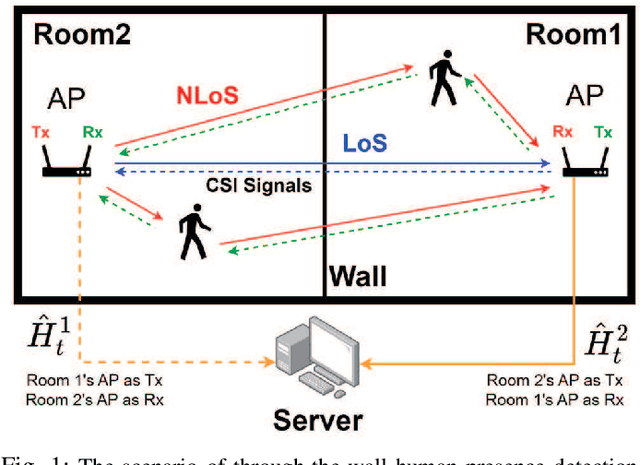

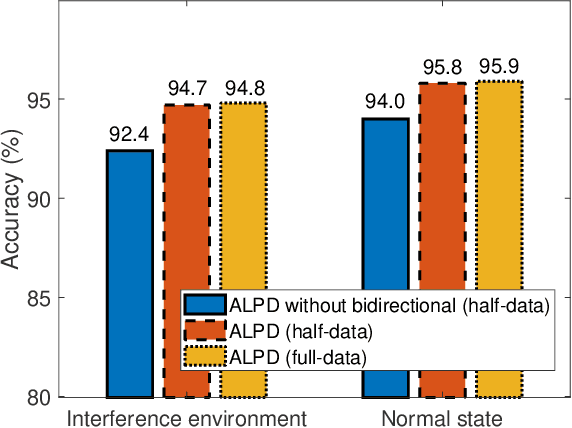
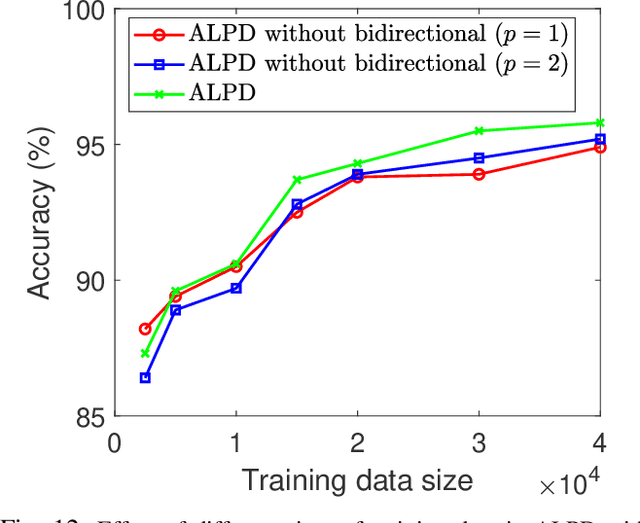
Abstract:Accurate detection of human presence in indoor environments is important for various applications, such as energy management and security. In this paper, we propose a novel system for human presence detection using the channel state information (CSI) of WiFi signals. Our system named attention-enhanced deep learning for presence detection (ALPD) employs an attention mechanism to automatically select informative subcarriers from the CSI data and a bidirectional long short-term memory (LSTM) network to capture temporal dependencies in CSI. Additionally, we utilize a static feature to improve the accuracy of human presence detection in static states. We evaluate the proposed ALPD system by deploying a pair of WiFi access points (APs) for collecting CSI dataset, which is further compared with several benchmarks. The results demonstrate that our ALPD system outperforms the benchmarks in terms of accuracy, especially in the presence of interference. Moreover, bidirectional transmission data is beneficial to training improving stability and accuracy, as well as reducing the costs of data collection for training. Overall, our proposed ALPD system shows promising results for human presence detection using WiFi CSI signals.
Attention-based Learning for Sleep Apnea and Limb Movement Detection using Wi-Fi CSI Signals
Mar 26, 2023Abstract:Wi-Fi channel state information (CSI) has become a promising solution for non-invasive breathing and body motion monitoring during sleep. Sleep disorders of apnea and periodic limb movement disorder (PLMD) are often unconscious and fatal. The existing researches detect abnormal sleep disorders in impractically controlled environments. Moreover, it leads to compelling challenges to classify complex macro- and micro-scales of sleep movements as well as entangled similar waveforms of cases of apnea and PLMD. In this paper, we propose the attention-based learning for sleep apnea and limb movement detection (ALESAL) system that can jointly detect sleep apnea and PLMD under different sleep postures across a variety of patients. ALESAL contains antenna-pair and time attention mechanisms for mitigating the impact of modest antenna pairs and emphasizing the duration of interest, respectively. Performance results show that our proposed ALESAL system can achieve a weighted F1-score of 84.33, outperforming the other existing non-attention based methods of support vector machine and deep multilayer perceptron.
 Add to Chrome
Add to Chrome Add to Firefox
Add to Firefox Add to Edge
Add to Edge